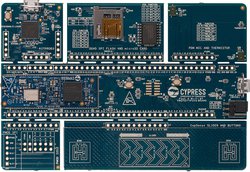
The Arm Mbed OS Unit Tests application executes all supported unit tests on the device.
The application is based on Matter and Arm Mbed OS, and validates Matter solution components directly on the device.
The Matter unit tests are included in a monolithic library and allow to validate most of the components used by Matter examples applications. The main goal of this application is to run registered tests on the device and check the results. The final result is the number of tests that failed.
Before building the application, check out the Matter repository and sync submodules using the following command:
$ git submodule update --init
Building the example application requires the use of ARM Mbed-OS sources and the arm-none-gnu-eabi toolchain.
The Cypress OpenOCD package is required for flashing purpose. Install the Cypress OpenOCD and set env var OPENOCD_PATH before calling the flashing script.
cd ~ wget https://github.com/Infineon/openocd/releases/download/release-v4.3.0/openocd-4.3.0.1746-linux.tar.gz tar xzvf openocd-4.3.0.1746-linux.tar.gz export OPENOCD_PATH=$HOME/openocd
Some additional packages may be needed, depending on selected build target and its requirements.
The VSCode devcontainer has these components pre-installed. Using the VSCode devcontainer is the recommended way to interact with Arm Mbed-OS port of the Matter Project.
Please read this README.md for more information about using VSCode in container.
To initialize the development environment, download all registered sub-modules and activate the environment:
$ source ./scripts/bootstrap.sh $ source ./scripts/activate.sh
If packages are already installed then you just need to activate the development environment:
$ source ./scripts/activate.sh
The Unit Test application can be built analogously to Matter examples ported to the mbed-os platform. It uses a custom script therefore it is a separate defined target.
Command Palette (F1) => Run Task... => Run Mbed Unit Tests => build => (board name) => (build profile)
${MATTER_ROOT}/scripts/tests/mbed/mbed_unit_tests.sh -c=build -b=<board name> -p=<build profile>
Both approaches are limited to supported evaluation boards which are listed in Supported devices paragraph.
Mbed OS defines three building profiles: develop, debug and release. For more details please visit ARM Mbed OS build profiles.
When using the building script, it is possible expand the list of acceptable targets; this may be useful for rapid testing of a new mbed-targets.
The Unit Test application can be flashed analogously to Matter examples ported to the mbed-os platform. It uses a custom script therefore it is a separate defined target.
The Open On-Chip Debugger is used to upload a binary image and reset the device.
Command Palette (F1) => Run Task... -> Run Mbed Unit Tests => flash => (board name) => (build profile)
${MATTER_ROOT}/scripts/tests/mbed/mbed_unit_tests.sh -c=flash -b=<board name> -p=<build profile>
Run and Debug (Ctrl+Shift+D) => Flash Mbed unit tests => Start Debugging (F5) => (board name) => (build profile)
The last option uses the Open On-Chip Debugger to open and manage the gdb-server session. Then gdb-client (arm-none-eabi-gdb) upload binary image and reset device.
It is possible to connect to an external gdb-server session by using specific ‘Flash Mbed unit tests [remote]’ task.
Debugging can be performed analogously to Matter examples ported to the mbed-os platform.
The Open On-Chip Debugger is used to to open and manage the gdb-server session. Then gdb-client (arm-none-eabi-gdb) connect the server to upload binary image and control debugging.
Run and Debug (Ctrl+Shift+D) => Debug Mbed unit tests => Start Debugging (F5) => (board name) => (build profile)
It is possible to connect to an external gdb-server session by using specific ‘Debug Mbed unit tests [remote]’ task.
The test results are streaming to serial output. To start communication open a terminal session and connect to the serial port of the device. You can use mbed-tools for this purpose (mbed-tools):
``` mbed-tools sterm -p /dev/ttyACM0 -b 115200 -e off ```
After device reset these lines should be visible:
``` [INFO][CHIP]: [-]Mbed unit-tests application start ... [INFO][CHIP]: [-]Mbed unit-tests application run ```
The unit tests application launched correctly and registered tests are executed.
The final result is the number of tests that failed:
``` [INFO][CHIP]: [-]CHIP test status: 0 ```
The application supports building and running on the following mbed-enabled devices:
| Manufacturer | Hardware platform | Build target | Platform image | Status | Platform components |
|---|---|---|---|---|---|
| Cypress Semiconductor | CY8CPROTO-062-4343W | CY8CPROTO_062_4343W |  | :heavy_check_mark: | LEDsBoard has only one usable LED (LED4) which corresponds to USER LED from UI. ButtonsUnused SliderUnused |
test_driver/mbed/mbed_app.json.